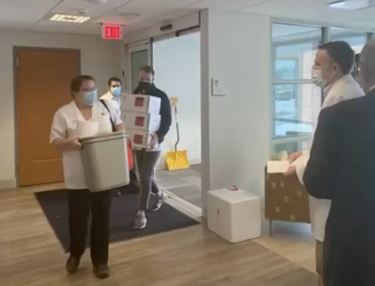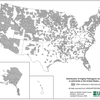Albany County’s death toll reaches 401 with another COVID victim
ALBANY COUNTY — Another county resident — a man in his sixties — has died of COVID-19, bringing the county’s death toll from the virus to 401.
Albany County Executive Daniel McCoy announced the death in a release on Friday morning along with the report of 116 new cases of COVID-19.
“We continue to see the impacts of this pandemic,” McCoy said in the release, “and we need to do more to get more people vaccinated and prevent these kinds of tragedies, because we know that the only way to truly protect yourself and your loved ones is by getting the shot.”
As of Thursday, 71.1 percent of all Albany County residents had received at least the first dose of the vaccine, and 65.2 percent have been fully vaccinated. The first dose vaccination rate for county residents who are 18 and older is now up to 82.1 percent.
Booster shots
On Friday, Rochelle Walensky, director of the Centers for Disease Control and Prevention, took the unusual step of overruling the CDC’s advisory panel to align the CDC’s policy with the Food and Drug Administration’s recommendation on more people being eligible for booster shots.
On Wednesday, the FDA had issued its guidance for a more limited use than the Biden administration had called for. Joe Biden had made the case for all Americans vaccinated against COVID-19 to get a booster shot.
The FDA included people 65 and older; people at high risk of severe COVID-19; and people whose frequent occupational exposure to the virus puts them at high risk of serious complications of COVID-19.
On Thursday, the CDC’s advisory committee had recommended that Pfizer-BioNTech booster shots should be given to people 65 and older, to nursing home residents, and to adults with underlying health conditions.
However, the CDC committee differed from the FDA, rejecting, in a split vote, giving booster shots to frontline health workers, first responders, nursing-home staff, teachers, and other essential workers.
Walensky’s decision put the CDC in line with the FDA’s casting of a wider net.
She said, in releasing the decision, “I believe we can best serve the nation’s public health needs by providing booster doses for the elderly, those in long-term care facilities, people with underlying medical conditions, and for adults at high risk of disease from occupational and institutional exposures to COVID-19.”
Walensky added, “We will address, with the same sense of urgency, recommendations for the Moderna and J&J vaccines as soon as those data are available.”
“On behalf of the long-term care industry, we appreciate the FDA and CDC for recognizing the threat of waning COVID-19 immunity and high-risk exposure. The FDA and CDC’s review of the data reiterates how incredibly effective and safe the COVID-19 vaccines are and how the booster shot will help continue to keep our residents and staff safe. This decision is another layer of protection that we need to fight this virus that uniquely targets our vulnerable long term care population,” said David Gifford, chief medical officer of AHCA/NCAL, in a statement on Friday.
The American Health Care Association and National Center for Assisted Living represents more than 14,000 nursing homes and assisted-living communities across the country that provide care to approximately five million people each year.
Gifford went on to call on state governments to coordinate distribution and administration of the booster shots.
“Long-term care facilities are diverse, so a one-size-fits-all approach will not work for a booster shot rollout,” he said, adding, “We also recognize that we must continue to increase vaccination rates, especially among our long term care workers ... The data also shows that cases in nursing homes will persist when community transmission is high.
Research: Moderna is the most effective
Separately, recent studies have shown that there is a difference in efficacy with the two messenger RNA vaccinations: Moderna is more effective than Pfizer-BioNTech.
The New England Journal of Medicine on Wednesday published a study showing Moderna was 96.3 percent effective compared to effectiveness of 88.8 percent for Pfizer-BioNTech. The study involved about 5,000 health-care workers in 25 states.
The study also said that both vaccines “were highly effective under real-world conditions in preventing symptomatic Covid-19 in health care personnel, including those at risk for severe Covid-19 and those in racial and ethnic groups that have been disproportionately affected by the pandemic.”
On Friday, the CDC published a study comparing the effectiveness of all three vaccines in preventing COVID-19 hospitalizations in adults in the United States who were not immunocompromised.
From March 11 to Aug. 15, 2021, Moderna’s effectiveness was highest at 93 percent followed by Pfizer-BioNTech at 88 percent, and then by Johnson & Johnson at 71 percent.
The study also said, “Although these real-world data suggest some variation in levels of protection by vaccine, all FDA-approved or authorized COVID-19 vaccines provide substantial protection against COVID-19 hospitalization.”
Newest numbers
Albany County’s five-day average of new daily COVID-19 cases is now up to 84.4, McCoy reported.
There are now 561 active cases in the county, up from 530 on Thursday. The number of county residents under quarantine decreased to 1,156 from 1,183. So far 88,793 people have completed quarantine to date.
There were four new hospitalizations since Thursday, and 40 county residents are still hospitalized with the virus – unchanged from Thursday. There are currently eight patients in intensive-care units, down from nine since the last update.



